Посты по тэгу: guide_page
Guide to Accounts Receivable Automation
October 26, 2023It’s all about getting paid
for B2B platforms
Gain insights in the significant challenges SMEs face with getting paid. Explore their current solutions and how you can solve their problems incorporating AR functionality within your platform.
Getting paid fast is essential for a small business to stay financially healthy. In B2B transactions, getting paid can be a real challenge due to extended payment terms. Since payments are often delayed, it becomes challenging for SMEs to keep track of who owes them money and when to expect it.
People start businesses with the aim of generating profits – which means that making money and getting it in the bank is one of the key ongoing tasks they have to deal with. The method through which business owners can receive their payment can vary depending on the nature of their business.
| Payment type | Description | Pain level |
|---|---|---|
| Online payments/checkout | e.g. online subscriptions or buying something on the website and paying for it with a credit card | Low – business is paid at the moment of purchase |
| Offline payment/checkout | e.g. buying something in a store with cash or card | Low – business is paid at the moment of purchase |
| Invoicing | Sending the invoicing for services done/to be done with 0-90/other days payment terms | High – 86% of invoices are paid late affecting SME cashflow |
10 years ago the picture would have looked different – even online payments were hard. Today, there’s an abundance of players to plug in online checkouts into your website. These ranges from turnkey solutions like Shopify or Wix to versatile providers like Stripe and Checkout, as well as industry-specific options like Squire or Motive.
Offline payments have improved significantly as well. What once was a game-changer with square, now there are multiple providers such as SumUp, Zettle, Lightspeed, and other new & traditional players. There are also verticalized specialists like Toast, offering a POS sytem tailored to the specific needs of their business type they focus on.
In recent decades, we saw payments moving online, becoming more lean and automated. Yet for many B2B transactions and for some B2C transactions payments have not improved that much – mainly because the process remained largely untouched when it comes to B2B transactions.
A simplified B2B process looks like this:
- Send the invoice to the client with a grace period of 30/60/90/more days
- Wait for the invoice to be paid
- Chase the payment if it’s not paid (potentially forever)
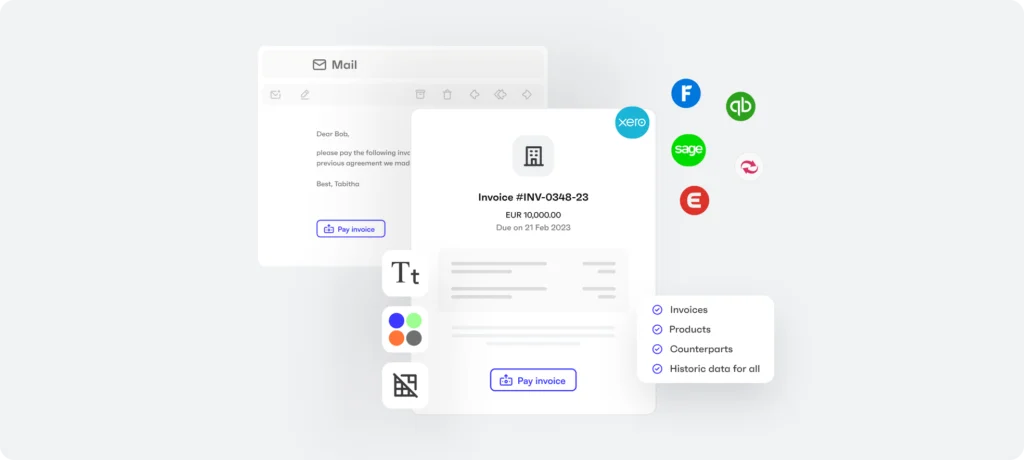
In the process above, businesses heavily depend on their clients paying the invoice on time. Unfortunately, clients often prove to be inefficient in this regard — they lose invoices, forget about them, or intentionally delay payment to hold on to their cash for as long as possible.
The process of chasing down these overdue payments is mostly manual and incredibly furstrating. It also poses a significant risk to particularly small businesses. These typically lack substantial cash reserves, so if several payments are delayed, it can seriously impact their financial stability and force them into a situation where they need to seek a loan or another financial solution.
Worst of all – many of these businesses aren’t aware they’re falling into this financial trap. Most of them lack real-time visibility into their cash flow. On one hand, they struggle to keep track of which invoices are overdue or about to become overdue. On the other hand, they only see the amount in their bank accounts and remain unaware of the outstanding obligations to their suppliers — leaving them in the dark about their true financial position.
Real-time cashflow simplified:
- Money in bank accounts
- − Outstanding obligations (salaries, payments to suppliers, expenses, etc.)
- + Expected revenue (invoices that are becoming due & other payments)
Revenue collection – biggest pain for SMEs
Revenue collection is one of the biggest pains SMEs have. The numbers below shed some light on the scale of this problem for businesses.
- 87% of SMEs are consistently paid late, disrupting cash flow and limiting opportunities to reinvest revenue
- 48% of SMEs suffer from losing invoice payments or missing payments, directly resulting in loss of revenue
- 50% of SMEs spend 7+ hours per week chasing late payments, distracting employees from their core business operations
- 12% of SMEs hire someone to chase late payments full-time, wasting resources on FTEs that could be strategically invested in staff who drive business growth
- 3.6 h/week wasted on average on manual payment tracking reconciliation, leading to unnecessary costs and potential inaccuracies due to human error
- 71% of SMEs have disconnected invoicing and accounting systems, resulting in excess manual work and a lack of real-time financial insight
Accounts Receivable process explained
Accounts Receivable (AR) is about handling outstanding invoices and payments. Small businesses specifically struggle with this due to the absence of specialized software that's within budget and is easy to use. Introducing AR automation can streamline the process, making it more efficient and cost-effective.
Simply put, accounts receivable (AR) process is the systematic management of outstanding invoices and payments owed to a company by its customers.
A simple AR process starts after service is performed or goods are delivered:
- Invoice is issued
- Invoice is paid
- Payment is reconciled
- Data is transmitted into accounting ledger
The above is just a simplification – in real life, the Accounts Receivable process is more complex than that. The full process is called Order-to-Cash – also referred to as O2C, OTC, or the quote-to-cash cycle.
A company’s business transaction begins with receiving orders from customers and performing the required services. After the work is done, they invoice the customers and then receive payment. The O2C cycle starts when an order is placed and ends when the payment is received & recorded in the general ledger.
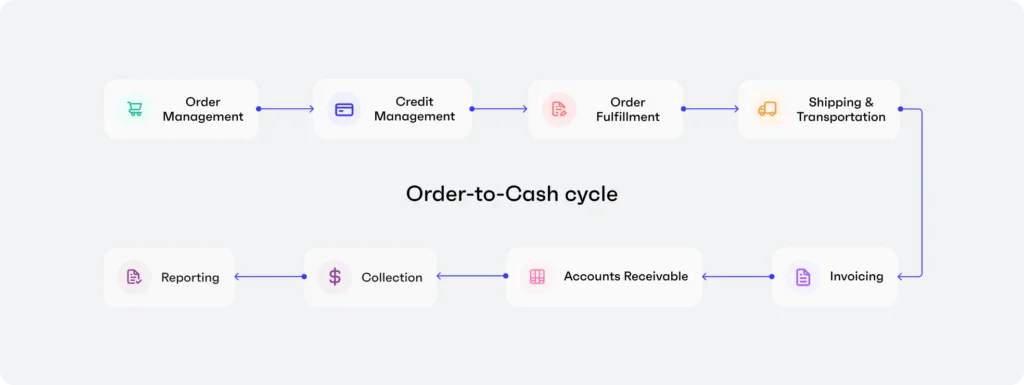
Accounts Receivable (AR) Automation alleviates the pain
Managing orders, offers, and invoices easily becomes a nightmare for small businesses without extensive finance teams. As a result, these businesses often struggle to properly keep track of sent invoices and their due dates – meaning they fail to send timely reminders and run into serious issues with collecting payments.
Most SMEs don’t use specialized software for invoicing. Instead, they rely on basic accounting tools, Microsoft Word and Excel, or even create one-off invoices in free online applications. This makes it hard to automate payments with – for instance, payment links and payment reminders.
The reason why businesses don’t use specialized software is simple — many find it impractical to use specialized software for a different operation in their business. Doing so would require them to adopt a multitude of tools, each catering to a specific area – making it too complex and expensive.
Nevertheless, SMEs would greatly benefit from Accounts Receivable Automation software, but then added within the platform they’re using every day for their business. They’d only pay a slightly higher bundled price, without needing to add or learn a new tool, while solving one of their key painpoints: collecting revenue.
AR impacts cash flow
Today’s status quo brings another challenge to SMEs. Due to the lack of proper insight or automation, business owners don’t know when they should take action regarding debt collection or consider services like factoring.
To make matters worse, hardly any invoicing or accounting tools offer a seamless integration with cash advance, factoring, or debt collection services. Instead, each of these services operate in silos: invoicing software is solely for creating and sending invoices, while factoring/cash advance providers function separately and require a business to register. In the end, uploading invoices requires many manual steps.
Invoicing → Revenue management
It becomes obvious that SMEs require more than just invoicing to address their “get paid fast” challenges; they need full revenue management functionality.
The difference between the two becomes very apparent if we look at the scope of the two solutions.
| Invoicing | Revenue management |
|---|---|
| Customer & product management | Customer & product management |
| Send offers | Send offers |
| Send invoices | Send invoices |
| Send data to accounting systems | Send data to accounting systems |
| – | Payment links |
| – | Payment reminders |
| – | Dunning mechanism |
| – | Cash advance & working capital |
| – | Factoring capability |
| – | Debt collection capability |
| – | Predictive cashflow analytics |
Today, there are almost no systems in the market that offer a full revenue manage capability. While many offer invoicing software, there is a significant gap when it comes to a complete system for revenue collection. We believe this is where the opportunity is.
Why offer Revenue Management to your business clients?
SMEs struggle with revenue collection but find standalone AR Automation solutions costly and complex. Platforms that integrate AR Automation into their existing services can enhance value, become primary B2B payment providers, and attract more users, following the success of companies like Toast and Brex.
SMEs are struggling with revenue collection and need help. They are increasingly open to using AR Automation software. BUT -it’s expensive and complex to implement a standalone solution.
As mentioned, most SMEs prefer to manage their revenue within the platforms they use daily, such as neobanks, vertical Software as a Service (SaaS) providers, or other tools they’re already familiar with. Since they’re accustomed to these software platforms already to manage their business, it’s much easier to switch from Word/Excel than to buy and learn new software.
In general, most businesses want one platform to run their business – it’s easy, efficient, and inexpensive compared to using 5-7 different tools. In response to this many neobanks, vertical SaaS players, and others are expanding their financial offering, aiming to become super-apps. This wave is just starting, but there are already champions we see in some segments of the market – for example, Toast in the restaurant industry, or Brex in the scale-ups ecosystem.
Now, you might be wondering, what’s in it for you? Well, there are numerous reasons why platforms start offering AP Automation to become the one-stop-shop solution for their customer.
Offering AR Automation to your business clients allows you as a platform to:
- Offer higher product value
- Become the core B2B payments provider to your clients
- Increase engagement, retention, and loyalty
- Increase revenue per customer – with SaaS & payments fees
- Attract more users as your offering becomes more compelling
- Surpass competition – hard to get clients who do AR with a competitor
We want to highlight one point here – being in the flow of B2B payments to your clients is key to great customer monetization.
Toast, for example, drives over 80% of their revenue from payments. However, it’s the software that enables you to monetize payments and drives the usage in the first place. So if you offer AP & AR Automation to users, you basically become their cashflow management platform, meaning you can monetize:
- All incoming payments (AR) – Payment links, BNPL for the end client, invoice factoring and more
- All outgoing payments (AP) – Single & bulk payments, BNPL, bill pay w/credit card, scheduled payments and more
- Cashflow gaps – Working capital optimization through financing, business loans, etc.
How can you monetize Revenue Management functionality?
You can charge for the software, transaction payments, and financial services to monetize revenue management. If you offer AR Automation as part of a one-stop solution, you can help your clients save costs. In addition, you can also earn payment fees (e.g. % of each transaction) from payment methods used to collect invoice revenue, potentially generating significant margins.
The best way to monetize revenue management functionality is to take a revenue cut from multiple sources – a fee for the software itself, payment fees for processing transactions, and financial service fees for features like cash advance or factoring.
Invoicing tools typically charge a basic monthly fee – ranging from free to $100s per month – depending on the level of automation, sophistication and their market positioning. Additionally, those that are payment-enabled can also monetize payments, attaching payment links to invoices, taking a cut when the user is paid. Depending on the client base, revenue from payment fees can account for up to two-thirds of the platform’s total revenue.
If you’d offer the full revenue management, you can potentially increase your earnings up to 2-5x the monthly + payment fees combined.
So when you offer Revenue Management software to your clients, you can monetize through:
- SaaS fees – Add AR to a premium package or charge a separate fee for AR functionality
- Payment fees – Get a % for each invoice paid with a payment link
- Financial services revenue – Get a % of each invoice that was used for cash advance, factoring, or debt collection
SaaS fees
Even though AR Automation functionality is adding a ton of value, you can’t offer it for a similar price like Radius or other competitors in the space. These companies specialize exclusively in AR Automation, so they can’t reduce their prices. As a result, they might lose potential clients who find their services too costly.
Being a one-stop-shop solution with AR Automation included allows you to offer more competitive prices to users – you could save them 2-5 times the costs compared to a standalone player.
- Adding AR into a premium package – this means quite a substantial de-facto discount on AR Automation functionality since only a fraction of the premium plan’s price can be attributed to AR. This approach is most effective when your premium package is already highly priced and produces high ROI – then discounting AR functionality will pay off
- Pricing AR Automation as an extra feature – this is the best strategy for most cases, as it simplifies revenue tracking and attribution to AR. For clients, this means they can use AR functionality when they need it, rather than being tied to a bundle that may include services they don’t require
Payment fees
Almost any payment these days costs money – and businesses are used to that. Moreover, they’re usually happy to pay extra for automation, convenience, and speed. When it comes to AR Automation, having payments as a part of your flow is invaluable – it helps your clients get paid faster and solves the reconciliation pain – as in that case payment is auto-connected to the invoice.
Here are the main payment methods you can monetize
- SEPA: Possible margins from €0.05 per payment and €9.50 for each active account. SEPA direct debit is a widely accepted and cost-effective method for B2B payments in Europe
- Cards: Margins of up to 0.4% of the payment. Card payments are widely accepted, making them one of the most convenient and common methods for transactions in today’s digital economy
- ACH: Margins go up to $4.50 or 1% of the payment. For each user, you can profit up to $8 per month, along with a one-time fee of $5. ACH is the preferred payment method for most B2B transactions in the US
- Buy Now Pay Later: Ranging from 2% to 8% for installments over 3, 6, and 12 months, respectively. This allows your clients to settle an invoice 30/60/90 days or even later past the due date
- Partial Payments: Ranging from 1% (for a 30-day term) to 4% (for a 90-day term). This option enables your clients to break down payments into smaller, more manageable installments
- Bulk Invoice Payments: The profit margins are in line with ACH, multiplied by the number of invoices paid. Your client can select multiple invoices to pay in one go, with support in the US provided by the ACH network
How hard is it to build AR Automation functionality?
To create a best-in-class AR Automation product, it's essential to provide all of the core functionalities. In addition, having accounting integrations seamlessly synchronized, ensuring regional tax compliances and adding integrated payments is what makes building AR automation complex.
Core AR Automation functionality
To develop a complete AR automation product that works smoothly, you need a robust set of core functionalities to bring it all together.
Data integration and extraction
- Data pull from accounting systems
- Customers database with flexible fields
- Products and services database
- Data push into accounting systems
- Conflict resolution capability
Customization and structuring
- Support for custom payment terms – per counterpart, project, or more
- Discounts management – per item, invoice, project, etc.
- Labeling & categorization for project management and more
Compliance
- VAT & tax compliance service
- Compliance system for document templates
- e-Invoicing compliance for applicable markets
- Functionality to issue compliant quotes
Invoice creation
- Ability to convert quotes to invoices manually/automatically
- Invoice creation functionality
- Credit notes issuing functionality
Payment processing
- Invoice payment links
- Basic payment reconciliation logic
- Advanced reconciliation options – partial payments, currency conversion, cash payments, and more
- Advanced KYC/KYB aligned across payment providers
Additional features
- Connectors to financial products like cash advance
- Data-driven upsell of financial products
- Accounting categories coding system
Accounting integration
To effectively implement AR Automation for clients, a seamless accounting synchronization is crucial. This often involves a complicated process, including the development of multiple API connections, data processing logic, conflict resolution mechanisms, and more.
In the AR process, one of the first steps your client would take is transferring data from their accounting systems into the platform. However, creating these integrations is more challenging than it might initially appear.
Small and medium-sized enterprises (SMEs) use a diverse range of accounting systems – there is not a single dominant platform. So it may as well be that you need to integrate with 15+ accounting systems to fully serve your customer base effectively.
Each accounting system has its unique way of handling data, ledger management and other functions. This means that there’s no one-size-fits-all approach to integrating accounting systems; each requires a tailored approach with customization. While integrators like Codat or Rails are available to streamline this process and save time, they’re expensive and often lack essential features such as data model standardization, API versioning and conflict resolution capabilities.
- Standardizing Data – accounting platforms vary significantly in how they manage data, containing numerous data types, each with its specific nuances. For example, different regions use distinct date formats and their own terminologies. A standardization layer is necessary to address these variations to make sure data is consistent across your platform
- Standardizing APIs – in a typical integration development scenario, you would have to handle your development processes separately for each accounting platform. However, for a more efficient approach, when dealing with 15+ integrations in parallel, it’s essential to build an standardization layer. This will streamline the process, making it much more straightforward as you’ll only need to interact with a single API, eliminating the need to make individual updates for each accounting platform
- Standardizing Configurations – the last piece where standardization is required is in how one change to synchronization, authorization or alert functions will be applied across all of your integrations
- Conflict resolution – an even more challenging aspect of accounting integrations is how to solve conflict resolution when data between two or more connected systems aren’t aligned. To address this well, you need a system capable of identifying these disparities.
For example:
- Imagine that someone manually entered information into two connected systems, now there are records with different ID numbers. You now need to find a way to merge these two records.
- Another common issue is when one system lacks data that is required by the other. You’d need to find a clever solution looking at common data points to send the right data from one to the other system.
Developing such an integration typically requires a year of dedicated effort from a senior developer. The workload is evenly split, where half of the time would be allocated on solving the standardization issue, and the other half focused on a solution for conflict resolution. This shows how complex building a best-in-class accounting integration system can be.
Regional tax compliance
Invoicing is usually highly regulated by tax authorities and there are a lot of requirements regarding document format, mandatory fields, VAT rate assignments, and more. Adhering to these regulations is necessary for all documents – ranging from invoices to delivery notes – otherwise, they might be inadmissible for tax purposes.
Developing and implementing compliance logic and engine can be one of the most challenging aspects of establishing a robust AR product. These engines must operate across multiple geographical regions, accommodate various business types, and address numerous edge cases.
This is where Monite comes in. Our solution comes with regional tax compliance included, covering document formats, VAT logic and more. Essentially, it’s a plug-and-play system.
Payments
The AR process is largely to collect money from customers. That is why a robust payment infrastructure is required to support this.
Payment links
The most basic version of to get paid is by attaching a payment link to every invoice that goes out or sending the link through email or text. While many invoicing solutions only offer payment options with cards or local methods (e.g. iDEAL, Bancontact, Cartes Bancaire, over 50% of invoice payments are still processed through ACH/SEPA banking networks. That’s why we emphasize the importance of incorporating ACH/SEPA payments within payment links – next to cards and local payment methods.
To design and offer a strong payment links product, platforms need to:
- Run a provider analysis and select providers for each payment type
- Integrate these selected providers
- Streamline an onboarding flow that satisfies all of the due diligence required from the payment providers
- Create a payment page product that consolidates multiple providers into a single interface
- Establish a reconciliation mechanism for each payment option
Financing options
For a comprehensive revenue collections process, it’s also crucial to provide solutions like factoring and cash advances. This by itself requires a wide set of logic and functionalities that contextualize the offering of these financial services and present the right offers and the right time to the right customer.
Also, financing products are usually very focused on a specific region (e.g. UK vs US) or business type (eCommerce vs Construction company), meaning that you will need to build a layer to connect multiple providers.
To offer robust financial services upsell functionlity, platforms need to:
- Build a universal connections layer
- Run provider search per end client type & region
- Select and integrate multiple providers
- Design custom logic how to offer financing options to clients
- Create a unified data collection process for credit underwriting
- Create reconciliation mechanism for each financing option
- Design all the flows related to financial products
KYC/KYB for payments
To use payment links or any other payment services, those sending invoices are typically required to complete a basic KYC/KYB (Know Your Customer/Know Your Business) process mandated by the payment provider. Often, different payment providers are used for different payment methods. This means that the client needs to undergo multiple KYC/KYB processes in order to use payment links. During this procedure, they are often required to provide information that platforms partially already have the initial onboarding. Such complexity can easily affect the adoption rate for payment links or other payment options.
To make this process smooth, Monite offers a unified onboarding product that allows platforms to:
- Do one KYC/KYB process that covers all providers simultaneously
- Store the data for future KYC/KYB processes – so no re-collection is needed
- Use all their existing customer data & ask only for missing fields
So what’s the alternative?
Strategy 1: Building Your Own AR Automation
You can either build AR Automation in-house, which takes a lot of time and money and might not be as competitive as specialized providers, or you can consider acquisitions as a quicker way to add invoicing automation, though it can be expensive.
There are a few large players that invested millions in building their Invoicing module in-house – e.g. Revolut or Oxygen. For players this size when the market offers cheap capital it’s a possible solution if they see AR capability as a core one for their strategy.
Finance automation products are complex to build – especially because they require covering a lot of edge cases. This is why to build a robust AR Automation solution you’ll likely need:
- 10-28 months of time – depending on the scope you want to build, level of expertise and agility in your team
- $600k to $9mn budget – depending on the type of end client and breadth of the solution
- $300-900k – annual maintenance and additional development costs
- A specialized product squad:
- Product people with AR Automation expertise – very hard to find
- Devs with expertise in payments/similar areas – creative thinkers who know how to take care of many edge cases
- UX designers – who built workflow products before and know how to make them very easy to use
What’s important to remember here though are two things:
- In-house built for super-apps is rarely competitive compared to a specialized provider – e.g. like Invoice2go
- Building in-house means not only building cost – but also continuous investment to maintain the product and grow its competitiveness as compared to vertical specialists
As a result, in-house builds take long and require a large investment.
M&A (Mergers & Acquisitions) is another route to add invoicing automation for your clients. It is very costly, but allows to go to market quicker and also grow your user base. For instance, SumUp, a leading European POS, acquired invoicing software Debitoor. Of course, this is an option for those who can afford an acquisition.
Strategy 2: Embedding AR Automation functionality
Monite, as an API-first player, offers flexible building blocks for AR Automation. This approach allows platforms to quickly add advanced AR Automation features, control the user interface, and expand modularly.
Up until 2022 M&A and building in-house were the only options. In 2022 a new market emerged in Embedded Finance – called Embedded ERP or Embedded AP/AR. We at Monite were the first international API-first player in the segment.
What we basically did is we built functionalities like Freshbooks and other AR Automation players – but we built them as flexible API blocks. This means that any platform can save 90-95% of development and maintenance costs and plug in those pieces in the way that works best for their clients in a couple of days. The backbone and all key functions are there, so all you need to do is to present the experience and interface that are optimal for your business users.
We made a $10mn+ investment to date into building a robust AR Automation solution, and we’re far from being done here. It’s expensive to build. The good news is that you don’t have to spend that money now – using our API you can go to market not with an MVP but with a product that is on the top players level and makes you very appealing compared to even specialists in the space.
3 great things to point out here
- User always sees your interface & thinks you built it – that’s because we’re API-first and you fully control UX/UI for the user, Monite is nowhere to be seen
- You can go live with 2 developers in 2 days to 2 weeks, and with a sub-$100k investment
- The solution is built modular like a big box of legos, allowing your more experienced partners to create value adding functionality on top of our core AR functionality, e.g. project management, budget management and analytics
What’s included in Monite API?
Monite provides a robust API that allows you to roll out a highly competitive AR Automation solution for your clients in just two weeks. Your users will have top-tier features, equivalent to or better than those offered by leading providers like Bill.com. These features are seamlessly integrated into your platform, branded under your name, and supported by our API.
Monite provides a developer-friendly API platform with a lot of different functionality that is essential to launch a competitive AR Automation product.
Platform
- Flexible API building blocks – all the functionality is built, you just decide how to plug it in and how you want it to work
- Fast back-end integration – ±1-2 days for a full backend integration
- Multiple options for frontend – pre-built frontend components (±2 days to integrate), SDKs (±1-2 weeks), or a fully custom built that you can do (usually ±3-6 weeks)
- Enterprise-grade security – API security is integrated across all layers of our platform, including internal development processes and partnerships with industry-recognized technology vendors
- Robust SLAs – dedicated to achieving the highest platform availability SLAs and have a proven track record of consistently meeting them

AR Automation functionality
- Data push and pull with accounting systems – we allow you to sync data from most major accounting systems. All it takes is for your users to authorize the connection. That way you can avoid starting from scratch and immediately make sense of historical data that is available while ensuring that all the invoices and transactions data will be automatically synced with the client’s accounting system

- Customers database – ability to create & store new clients and partners, comes with customizable fields and settings, e.g. preferred accounts, payment methods, and more
- Payment terms service – ability to set multiple payment terms based on conditions, customer, etc.
- VAT service – ability to provide a list of applicable and compliant VAT rates based on the region, business and product type, and more
- Discounts service – an ability to add discounts on invoices, items, or other basis. Ability to add discounts based on specific rules to reflect promotions happening, and more
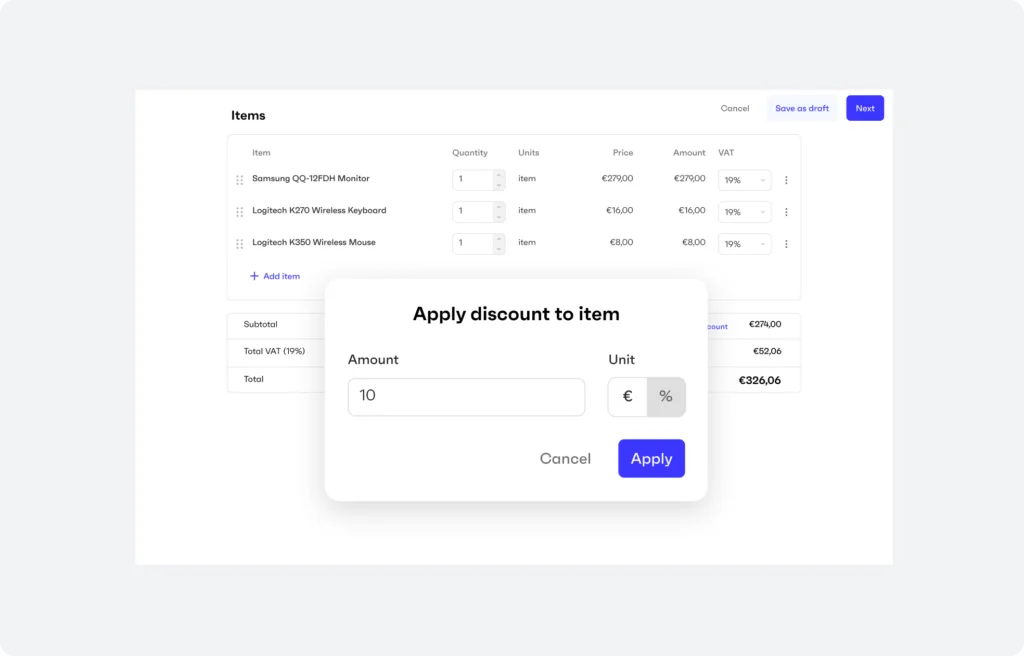
- International document compliance – compliant format for each document type based on the business location, tax regulation, and many other parameters
- Sending quotes – ability to send a commercial offer to clients. Quotes can be accepted online or replied to with comments for easy adjustment, and then edited for resending
- Quotes to invoice conversion – auto or manually convert accepted offers to invoices
- Sending invoices – invoice clients with professional-looking invoices, including custom notes and any context needed around the deal
- Custom email design and copy – customize the email templates that the end clients will receive, connect your own email domain, and more
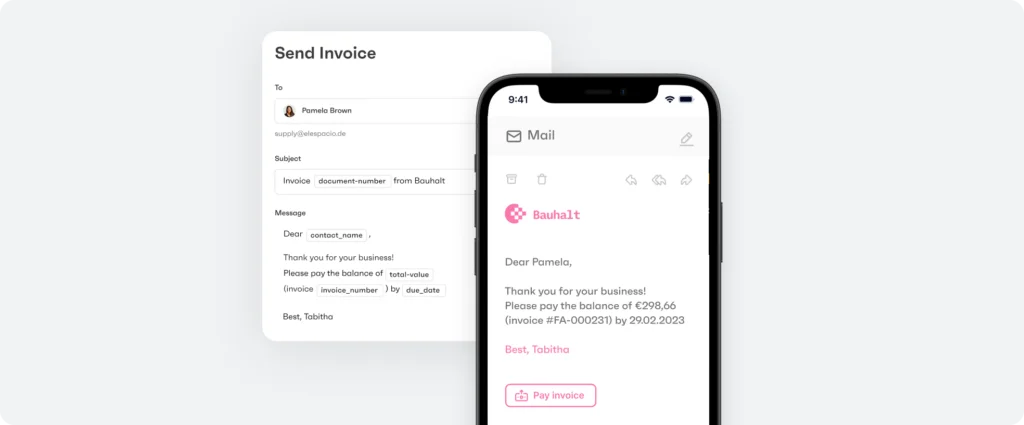
- Recurring invoices – send invoices on a specific cadence
- Compliant invoice editing – changing invoices in a compliant manner accepted by the tax authorities
- Self-invoicing – automatic invoicing issuing based on the work done – e.g. On behalf of contractor once the job has been submitted and approved
- Invoice payment links – ability for the end client to pay the invoice with card, ACH/SEPA or local payment methods
- Light & unified KYC – do one KYC for multiple payment methods, use your existing customers data to speed up the KYC process
- Payment reconciliation – connecting invoices to payments, auto-marking invoices paid
- Multi-payment support – ability to log multiple payments per invoice, including bank, cash, and other payments
- Support for partial payments – ability to recognize partial payments, including setting thresholds for currency conversion or bank fees difference when invoices appear e.g. 98% paid
- Compliant payment reminders – ability to set custom compliant reminders for unpaid invoices
- Compliant dunning process – sequence of steps allowing to then submit the invoice to a collections agency or similar
- Credit notes – ability to cancel invoices in a compliant way, while sending or just storing a cancellation note
- Data push into accounting systems – all the invoices and transactions data will be automatically synced with the client’s accounting system
- Conflict resolution capability – ability to find, flag, and resolve conflicts between the accounting system and your system. This is requires to perform automated two-way data syncs with accounting platforms – a must-have for any business
- Audit trail – full log of events and changes, which is required for most of internal/external audits and for finding errors
How to get started?
Learn more about our AR Automation solutions and features on our Accounts Receivable page.
A great way to get started is to get a demo of Monite – just request it via a link and we will find the time to connect you with one of our product experts.
As we continue the talks, we will help you build a business case and a revenue projection for AR Automation functionality. At the same time, we will provide all the necessary tech & product documentation, so you can assess the Monite API from the perspective of shipping the right value to your users.
Guide to Accounts Payable Automation for Founders and Product Leaders
October 19, 2023Understand the key pains SMEs have in Accounts Payable (AP) area and how you can solve it for them by adding AP functionality inside your platform.
What are Accounts Payable?
Accounts Payable (AP) are expenses and invoices that are yet to be paid by a business – e.g. an unpaid supplier invoice. In B2B transactions, these invoices often come with payment terms, making transactions more complex and extended in nature, requiring extensive tracking and maintenance.
For anyone running a business, there is always the sales side of things and the spending side of things. The spending side includes multiple aspects that could generally be split up into
| ±20% of expenses | ±10% of expenses | ±70% of expenses |
|---|---|---|
| Expenses that are paid on the spot – e.g. buying construction materials in a store with a credit card | Reimbursable expenses – e.g. reimbursing a sales person for a flight they paid themselves | Expenses or invoices that are yet to be paid – e.g. paying suppliers for goods |
This last part is exactly what Accounts Payable are – these are basically all outstanding payments the business needs to make. Usually, it’s as simple as payments to suppliers.
So, why do Accounts Payable even exist? In B2B (business-to-business) transactions, payment terms are typically more complex than simply paying cash up-front. Most transactions involve getting goods first and then paying for them 30/60/90 days later. Unrealized payments flow in and out – which means accurate tracking and accounting require increased effort and specialized software.
A simple AP process consists of:
- Ordering goods
- Receiving an invoice
- Checking the invoice for accuracy
- Getting approval for payment
- Making a payment
- Reconciling a payment
- Submitting the data into the business’ accounting software
However, the above is just a simplification – in real life Accounts Payable process is often more complex than that. The full process is called Procure-to-Pay (P2P) – it is an end-to-end purchase process that includes order requisition, vendor selection, PO (purchase order) creation and submission to suppliers, receipt of goods/services, and processing of invoices for payments.
In simple terms, it’s exactly how real business works – it starts with vendor search and selection, then come purchase orders, and only then come invoices and payments, followed by reconciliation, accounting, and reporting.
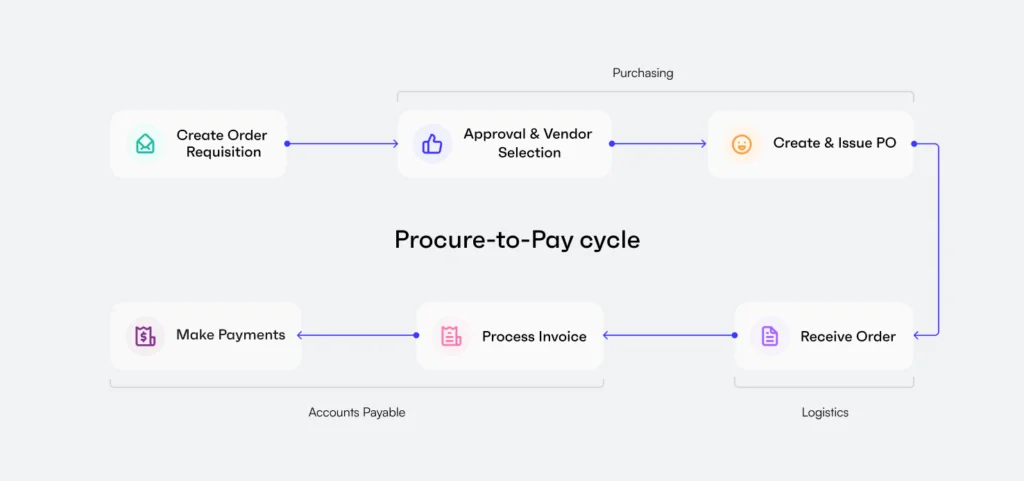
Challenges in AP Management:
01
Lack of process:Many companies, especially SMEs, lack a well-established AP process, often resulting in a disorganized approach to financial management. A lack of unified tracking tools further complicates AP management.
02
Manual operations:Resource-intensive manual AP operations heavily rely on forms and spreadsheets, consuming substantial resources in terms of time, effort, and personnel. The manual nature of these processes increases the risk of errors and inefficiencies, leading to potential financial discrepancies, duplicate payments and losses.
03
Inadequate Approval Processes:The convoluted approval processes within many companies can be so intricate that even large corporations may inadvertently miss payments or fall victim to fraudulent activities. Even Finance teams at giants like Google and Facebook can be fooled by fraudulent invoices
How big is the struggle?
Account Payable and bill payments are an overlooked pain, many don’t realize how big it is. The numbers below shed some light on the scale of this problem for small businesses:
- $6-15 average cost per processed invoice depending on the SME size – SMEs waste tens of thousands of dollars per year on invoice processing.
- 82% of SMEs miss early payment discounts, resulting in lower margins and hurting the company’s cash position.
- 54% of SMEs pay their bills late regularly, due to inconsistent invoice formats and chasing approvals.
- Up to 10% in late payment fees, adding unexpected costs to the business.
- 47% of invoice approvals are slow, leading to suppliers being paid late and straining SME-vendor relationships.
- 23% of businesses lack visibility of outstanding liabilities, resulting in missed payments, late fees, and cash flow mismanagement.
How can AP Automation help?
In an effort to reduce the burden, SMEs are increasingly turning to specialized AP Automation software. Tech tools provide organizations with better control over their supplier relationships, payment processes, and the automation of critical internal tasks, leading to a wide range of significant advantages:
- Hundreds of Hours Saved: AP Automation software streamlines time-consuming manual tasks, freeing up valuable hours for your team to focus on strategic activities, innovation, and growth.
- Increased Process Efficiency: Automation enhances the efficiency of AP processes by reducing human error and expediting invoice processing and payment approvals.
- Reduction of Fraud and Inaccurate Invoices: Robust fraud detection algorithms and invoice validation mechanisms minimize the risk of falling victim to fraudulent activities or processing inaccurate invoices.
- Real-Time Visibility: Gain real-time insights into your financial transactions, supplier relationships, and payment statuses, allowing for informed decision-making and financial planning.
- Easy Compliance: Ensure compliance with financial regulations and company policies effortlessly through automated tracking and reporting, reducing the risk of costly errors or penalties.
- Better Visibility into Suppliers and Prices: AP Automation provides comprehensive supplier management tools, enabling you to evaluate supplier performance, negotiate better prices, and strengthen your supplier relationships.
- Better Spending Control: Tighten control over expenditures by setting spending limits, automating budget tracking, and gaining insights into spending patterns, ensuring financial responsibility across the organization.
- Avoidance of Late Payment Penalties: Eliminate late payment penalties by automating payment schedules and ensuring that payments are made on time, preserving your company’s financial reputation.
Why offer AP Automation to your business clients?
Businesses prefer to have a one-stop-shop solution to manage their business, so if they already manage a part of it with you, you might as well help them with AP Automation. Doing so enables you to earn more per client, drive more engagement, and become their core B2B payments provider – making you more competitive and allowing faster growth.
While AP Automation software is very useful, it’s expensive and requires integration into company’s processes, onboarding training, and more.
Also, a small business owner is already using a dozen tools to run the company. Does she really want to add one more and then change your processes that require learning a new platform and training your team, all while paying $50-300 per month? Many would likely argue that this doesn’t seem appealing.
What most SMEs prefer is to get AP Automation within the platform they use every day – e.g. neobank, vertical SaaS, or something else. They’re used to the software, they use it to manage the business anyway, and now they can switch from Excel to a new feature in the existing platform – a lot easier for them than buying and learning new software.
In general, most businesses want one platform to combine all of their business processes – it’s easy, efficient, and inexpensive compared to using 5-7 different tools. In response to this, many neobanks, vertical SaaS players, and Accounting platforms have started becoming “super-apps” – becoming one-stop-shop solutions for their users. This wave is just starting, but there are already champions we see in some segments of the market. For example, Toast – a platform for restaurant owners, or Brex, offering a comprehensive corporate expense management system for startups and scale-ups.
Why should you consider offering AP Automation to your business clients as a platform?
Well, there are several compelling reasons why platforms choose to embrace AP Automation and evolve into super-apps.
Offering AP Automation to your business clients allows you as a platform to:
- Enhance Product Value and offer better spend management and savings to your customers
- Increase share of wallet by becoming the primary payment provider
- Increase Revenue per user
- Differentiate from competition
- Attract new users by offering a new service
- Leverage data & insights to upsell financial and other products
Being in the flow of B2B payments to your clients is key to great customer monetization. Toast, for example, drives over 80% of its revenue from payments, despite being primarily a restaurant management software. However, it’s the software that enables you to monetize payments and drives usage in the first place.
Similarly, if you offer AP & AR Automation to users, you basically become their cash-flow management platform, meaning you can monetize:
- All incoming payments (AR) – Payment links, bank transfers, card payments, etc.
- All outgoing payments (AP) – Single & bulk payments, bill pay w/credit card, and more
- Cash-flow gaps – Working capital optimization solutions, business loans, etc.
How can you monetize AP Automation functionality?
Platforms can monetize AP Automation functionality via SaaS fees (extra fee or premium plan) and payment fees (e.g. % of each transaction). Given the high costs of this functionality in the market, platforms can easily earn 3-5x ARPU on businesses using their AP module.
AP Automation is one of the most expensive software solutions on the market. The likes of Bill.com can easily cost $300/mo, and we are talking only basic AP Automation functionality for a smaller company. More comprehensive Procure-to-Pay solutions like Stampli or Tipalti can easily cost $1k/mo+. These platforms also monetize payments on top of SaaS fees, with payment fees often being hefty and containing a lot of hidden charges (e.g. fees for currency conversion).
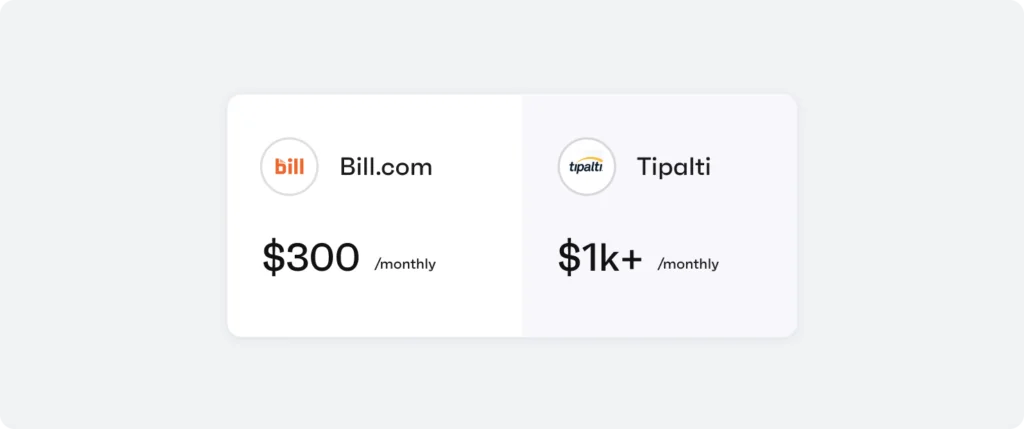
When you offer AP Automation software piece to your clients, you want to mimic the existing market model and monetize both SaaS fees and payments.
- SaaS fees – add AP to a premium package or charge a separate fee for AP functionality
- Payment fees – get markup from payments your clients process
SaaS fees
The market tells us SMEs value AP Automation functionality – but that doesn’t mean you want to price like Bill.com or a similar player. Remember – for those companies AP Automation is the only thing they do – which means they also miss out on a lot of clients for whom this is very expensive.
Being a one-stop-shop solution with AP Automation included allows you to offer more competitive prices to users – e.g. you could save them 2-5x compared to a standalone player.
- Adding AP into a premium package – this means quite a hefty de-facto discount on AP Automation functionality as you’d only be able to attribute a fraction of the premium plan price to AP. It is the best strategy if your premium package is high price and produces a high ROI overall – then discounting AP functionality will pay off
- Pricing AP Automation as an extra feature – this is the best strategy for most cases, making your revenue from AP easy to track and attribute. For clients, it means they’re taking it and using it when they need it – while in a bundle they could get the bundle, but not need AP.
Payment fees
Payment processing costs money – and businesses are used to that. Moreover, they’re usually happy to pay extra for automation, convenience, and speed. When it comes to AP Automation, having payments as a part of your flow is invaluable – as it saves your clients a lot of time.
Here are the main payment methods you can monetize:
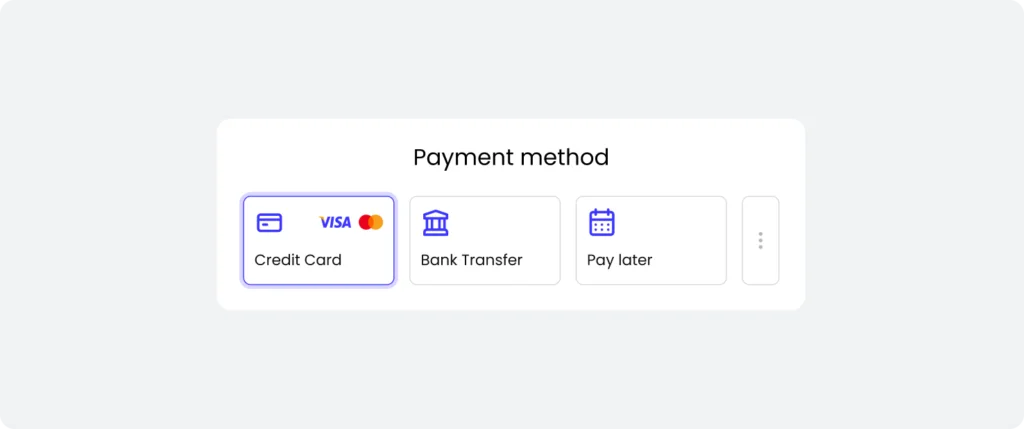
- SEPA – from €0.05 per payment and €9.50 for each active account. SEPA direct debit is the go-to method for B2B payments in Europe. It’s widely accepted and cost effective.
- ACH – up to $4.50 or 1% of the payment. For each user you can charge up to $ per month, plus a one-time fee of $5. ACH stands out as the go-to payment method for most B2B transactions in the US.
- Buy Now Pay Later – from 2 to 4 and 8% in installments for 3, 6 and 12 months respectively per payment. This allows your clients to pay an invoice 30/60/90 days or more past due date.
- Partial payments – from 1% (30 days term) to 4% (90 days term)%. Allows your clients to split up the payment into smaller manageable payments.
- Bulk invoice payments – margins are those of ACH multiplied by the amount of invoices paid. Your client can select multiple invoices to pay in one go supported in the US by the ACH network.
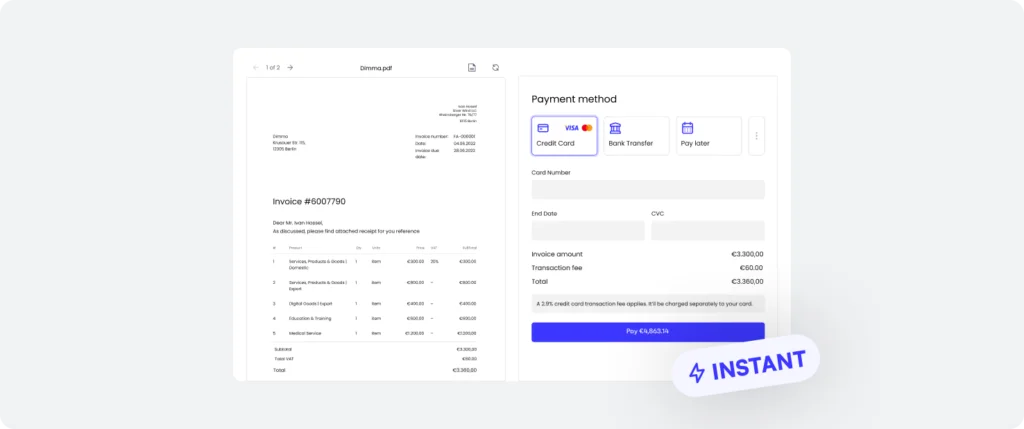
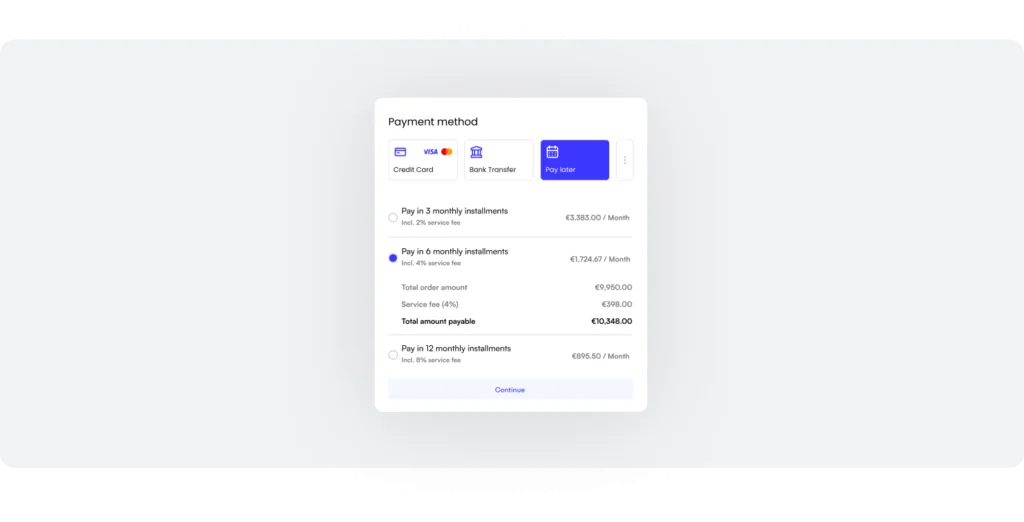
How hard is it to build AP Automation functionality?
Core AP Automation functionality
To craft a smooth AP Automation workflow that works seamlessly and sets up apart, you’ll need a solid set of core functionalities to make it all come together.
Below are some of the key categories:
Data Integration and Extraction:
- Data pull from ERP/Accounting system
- Counterparts database
- Mailboxes for invoices
- Dynamic invoice tables with filters
Document Processing:
- Robust OCR engine, ideally with daisy-chaining and ML mechanism designed for AR/AP
- Invoice validation mechanism
Approval Workflow:
- Approval rules builder with flexible parameters
- Approval workflow engine
- Approval/commentary notifications system
Payment Processing:
- Payment release system with integrated ACH/SEPA, card, and other rails
- Bulk payments and partial payments
- Payment reconciliation logic
Data Integration and Reporting:
- Accounting categories coding system
- Data push into accounting systems
- Conflict resolution capability
- Audit trail
Additional Features:
- Customizable reporting and analytics
- Supplier/vendor portal for self-service
- Compliance and regulatory features
- User roles and permissions management
Accounting Integration & Data sync (must-have)
To implement AP Automation successfully for clients, accounting synchronization is a necessity. Enabling this is usually extremely complex and requires building multiple API connections, data processing logic, conflict resolution engines, and more.
In the accounts payable process, one of the final steps involves transferring data into various accounting systems, but building these integrations can be more challenging than it seems.
SMEs use many different accounting systems, so to fully serve your customer base effectively with automated accounts payable (AP), you often need to integrate with 15+ accounting systems, which is a significant challenge.
Each accounting system has their way of looking at the data, running a ledger, etc. This means that there is no standard way to integrate an accounting system, each would need a specific approach and customization. While integrators like Codat or Rails are available to simplify the process, and can save you time, they tend to be expensive and still lack certain essential features, such as data model unification, API versioning, and functionalities like conflict resolution.
- Data Standardization – accounting platforms vary significantly in how they handle data. They contain numerous data types and thousands of fields, each with its own nuances. For instance, different regions use different date formats and terminologies. A standardization layer is needed to handle these variations and ensure consistent data retrieval.
- API Standardization – when you build integrations individually, you’ll need to manage development separately for each accounting platform. However, using an integration platform with a standardization layer simplifies this process. Your developers can work with a single API, eliminating the need to keep up with updates for each accounting platform’s API.
- Configuration Standardization – when you make changes to how synchronization, authorization, or alert rules work, you want these changes to apply effortlessly across all your integrations with just one action.
Conflict resolution
One of the trickiest parts of accounting integrations is solving conflicts. This happens when data doesn’t match up between two connected systems. To handle this, you need a smart system that can spot these differences. Here are 2 examples:
- Imagine someone manually entered information into both systems that are supposed to work together, but now they have different ID numbers. To make these systems work smoothly, you have to combine these conflicting pieces of information.
- Another common issue is when one system is missing data that the other system needs. Finding a good way to fix this is really important for keeping everything working well together.
Building such an integration is no small feat. It typically demands a year of dedicated work from one senior developer. The workload is split almost evenly, with half the time devoted to standardization and the other half focused on building the conflict resolution functionality. This highlights the considerable time and effort required for this complex task.
Strategies to add AP Automation functionality
Strategy 1: Building Your Own AP Automation
Building AP Automation functionality in-house requires hiring a specialized team and committing to an investment of $1-2 million, along with 1-2 years of development time. Ongoing maintenance and development are necessary to remain competitive in this space.
There are a few large players that invested millions to build their AP Automation module in-house – e.g. Brex or Ramp. For players this size when the market offers cheap capital via VC or loans it’s a possible solution if they see the AP capability as a core functionality for their strategy.
Finance automation products are complex to build – especially because they are required to cover a lot of edge cases. This is why building a robust AP Automation solution likely requires something like:
9-28 months of time – depending on the scope you want to build, level of expertise and agility in your team
$500k+ budget – for the smallest build and up to €5-10mn for a robust capability
$200-800k – annual maintenance and additional development costs
A specialized product squad
- Product people with AP Automation expertise – very hard to find
- Devs with expertise in payments/similar areas – creative thinkers who know how to take care of many edge cases
- UX designers – who’ve built workflow products before and know how to make them very easy to use
What’s important to remember here though are two things:
- In-house built super-apps are rarely competitive when compared to a specialized provider – e.g. Bill.com
- Building in-house means not only building costs but also a continuous investment to maintain the product and grow its competitiveness as compared to vertical specialists
As a result, in-house builds typically come at a high cost and effort, requiring a large ongoing investment.
Another route to add AP Automation for your clients is via M&A (mergers and acquisitions). It is very costly, but theoretically, it can also allow you to go to market quicker and grow your user base. For instance, Toast, a leading platform for restaurants, acquired AP software xtraCHEF. Of course, this is an option for those who can afford an acquisition.
Strategy 2: Implementing an embedded AP Automation Solution
Monite invested over $10mn to make a robust AP Automation solution that you can use via an API. It is a fraction of the in-house building cost and takes 2 weeks to plug in with 2 developers. Monite’s solution includes robust AP functionality and accounting integrations. We handle all the building and maintenance costs, ensuring your solution remains competitive in the market.
Up until 2022 M&A and building in-house were the only options. In 2022 a new market emerged in Embedded Finance – called Embedded ERP or Embedded AR/AP. We at Monite were the first international API-first player in the segment.
What we effectively did was build functionalities like Bill/Stampli and other AP Automation players – but we built them as flexible API blocks with a focus on serving platforms first. This means that any platform can save 90-95% of development and maintenance costs and plug in those pieces in the way that works best for their clients with minimal integration effort. The backbone and all key functions are there, so all you need to do is to present the experience and interface that are optimal for your business users.
We made a $10mn+ investment to date into building a robust AP Automation solution, and we’re far from being done here. It’s expensive to build. The good news is that you don’t have to spend that money now – using our API you can go to market not with an MVP but with a top-tier product that makes your own offering even more appealing – compared to both competitors in the space and specialized AP Automation companies.
Two additional things to know:
- Your user always sees your interface and brand only – that’s because we’re API-first and you fully control UX/UI for the user, Monite is nowhere to be seen
- You can go live with two developers, in 2 days to 2 weeks, and with a sub-$100k investment.
What’s included in Monite API?
Monite provides a robust API that allows you to launch a very competitive AP Automation solution for your clients in 2 weeks. Users receive all the expected features – same or better than what they’d get from a leading provider like Bill.com – but within your interface and offered by your brand, supported by our API.
Monite provides a developer-friendly API platform with a wide range of functionality that is essential to launching a competitive AP Automation product.
Platform
- Flexible API building blocks – all the functionality is built, you just decide how to plug it in and how you want it to work
- Fast back-end integration – ±1-2 days for a full backend integration
- Multiple options for frontend – pre-built frontend components (±2 days to integrate), SDKs (±1-2 weeks), or a fully custom built that you can do (usually ±3-6 weeks)
- Enterprise-grade security – API security is integrated across all layers of our platform, including internal development processes and partnerships with industry-recognized technology vendors.
- Robust SLAs – dedicated to achieving the highest platform availability SLAs and have a proven track record of consistently meeting them.
AP Automation functionality
- Data push and pull with accounting systems – we allow you to sync data from most major accounting systems. All it takes is for your users to authorize the connection. That way you can avoid starting from scratch and immediately make sense of historical data that is available while ensuring that all the invoices and transactions data will be automatically synced with the client’s accounting system
- Counterparts database – the ability to create and store new suppliers and partners, comes with customizable fields and settings, e.g. preferred accounts, payment methods, and more
- Mailboxes for invoices – the ability to create forwarding addresses for invoices on a per-team/per-person/per-company/etc. basis, also using your domain. That way once the new invoice arrives to a person, they know where to forward it for AP processing. It can also be used to give this email to suppliers directly, so you avoid cluttering your own email
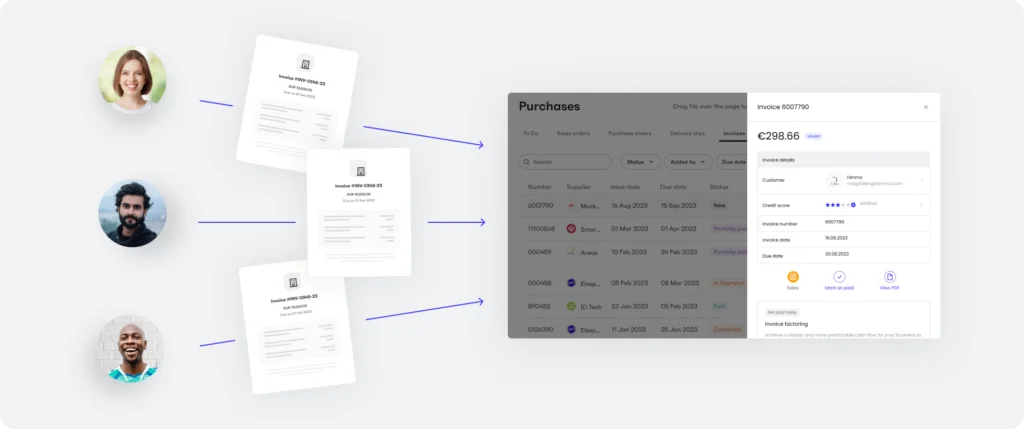
- Dynamic invoice tables with filters – see all invoices in one place, sort/filter by many parameters, dynamic search, ability to create views based on invoice workflow, and more
- Robust OCR engine – we use multiple OCR providers to guarantee the highest quality of recognition. We also use ML learning to improve accuracy using a gigantic dataset that flows through our system and apply OCR engines one after the other until the target quality of recognition is achieved
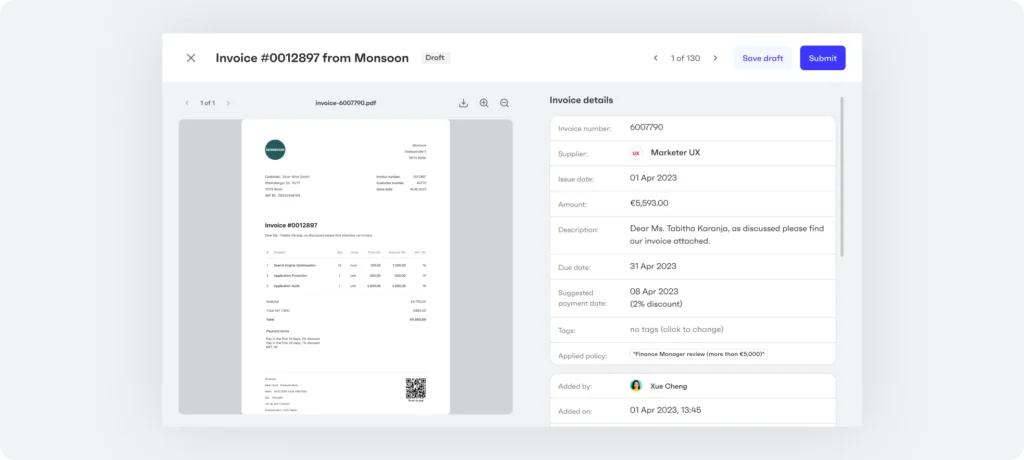
- Invoice validation mechanism – capability to make sure that invoice data is correct and actionable, that all the key fields needed for payment & accounting processing are in place
- Commenting & to-dos engine – ability to leave comments and assign to-dos for invoices – key to intra-company collaboration. This allows the approver to request a change (e.g. adjust the address on the invoice), while the document entry stays the same and just the new version of the document is being added
- Approval rules builder with flexible parameters – the ability to mimic companies’ approval policy, e.g. by department, cost center, purpose, city, team, person, amount, tag, and more
- Approval workflow engine – the ability to build multi-step approval flows with AND/OR logic, and more
- Approval/commentary notifications system – notifications for assigned to-do items, comments, and pending approvals
- Payment release system – functionality to pay invoices with ACH/SEPA open banking rails. In the future – with a card, BNPL, and other means
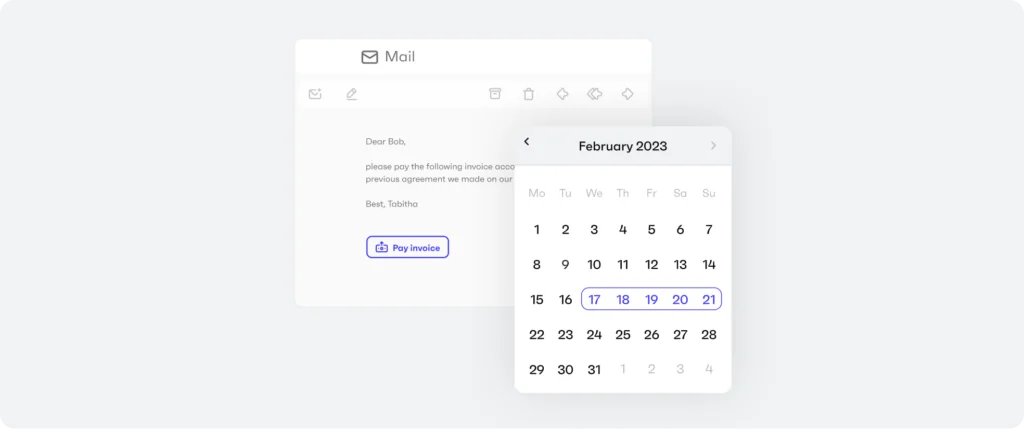
- Bulk payments and partial payments – the ability to pay invoices in part and in bulk
- Payment reconciliation logic – connecting documents to payments, marking invoices as paid, preparing the data for accounting push
- Manual payments log – ability to log payments manually, including cash & partial payments
- Accounting categories coding system – ability to suggest and assign GL categories in cases where it’s required for accounting system data push
- Data push into accounting systems – all the invoices and transactions data will be automatically synced with the client’s accounting system
- Conflict resolution capability – ability to find, flag, and resolve conflicts between the accounting system and your system. This is required to perform automated two-way data syncs with accounting platforms – a must-have for any business
- Audit trail – full log of events and changes, which is required for most of internal/external audits and for finding errors
How to get started?
Learn more about our AP Automation solutions and features on our Accounts Payable page.
Or get in touch and we will help you build a business case and a revenue projection for AP Automation functionality. At the same time, we will provide all the necessary tech & product documentation, so you can assess the Monite API from the perspective of shipping the right value to your users.